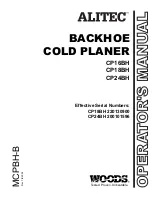
10 Operation
MCPBH-B (Rev. 4/20/2007)
Operating Planer
1. Adjust the planer to desired cutting depth by
adjusting the depth jack (1) as shown in Figure 2.
2. Position the host machine so that it is parallel to the
surface being planed.
3. Begin with the planer drum slightly off the ground
and the planer close to the host machine.
4. Activate the auxiliary hydraulics and slowly lower
the planer until the drum contacts the ground.
NOTE: For proper planing, the secondary bucket
pin should be removed to allow the planer to swing
freely about the primary bucket pin.
5. Slowly lower the planer until all four planer wheels
are on the ground. If the drum stalls, raise the
planer until the drum begins turning, then lower the
planer again.
6. When the planer is fully lowered, begin moving the
planer away from the host machine, so that the
drum is cutting on the upstroke. Plane at a rate to
prevent the drum from stalling. If the planer stalls,
raise planer out of the cut to allow the drum to
begin turning and continue planing.
NOTE: For optimal cutting and reduced vibration,
maintain down pressure on the planer with all four
wheels on the ground while cutting.
Figure 2.
NOTICE
■
Keep the planer drum close to the ground.
Avoid swinging the boom from side to side while
planing as this may produce excessive drum wear
or planetary failure.
Attaching The Planer To A Backhoe
1. Position the planer as shown in Figure 3.
2. Move the dipper stick so the primary pin bore on
the dipper stick is aligned with the primary pin bore
(1) on the planer.
3. Insert and secure the primary pin.
4. Activate the curl function until the curl pin bore is
aligned with the curl pin bore (2) on the planer.
5. Insert and secure the curl pin.
Figure 3.
NOTICE
■
Do not overcurl attachment. Overcurling may
cause damage to hose, machine, or attachment.











































